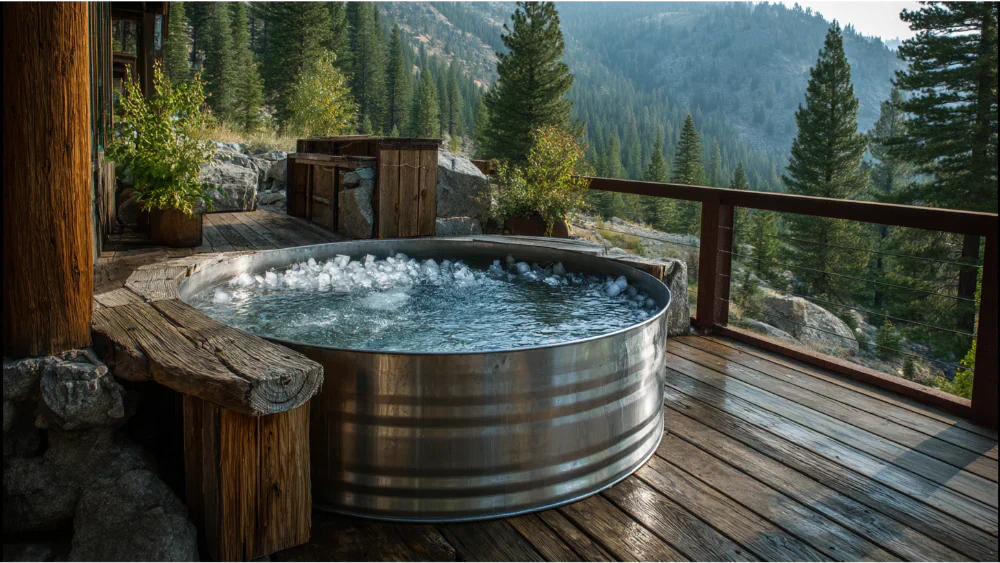Cold plunges offer more than just a jolt to the senses. When done with precision and consistency, cold water immersion unlocks a wide range of health benefits, from improved blood flow and reduced inflammation to sharper focus and elevated mood. But none of those benefits matter if the water temperature isn’t dialed in. In this in-depth guide, we’ll explore the science, strategy, and structure behind choosing the ideal cold plunge temperature for your body, your lifestyle, and your goals.
Why Cold Plunging Is More Than a Trend

Cold exposure has surged in popularity in the last decade, driven by athletes, wellness professionals, and high-performance individuals looking for efficient tools to improve mental and physical well-being. But the practice is far from new. Cultures around the world have embraced cold water rituals for centuries, from the Finnish ice bath tradition to Japanese Misogi to Slavic snow bathing.
Today, cold plunge therapy is embraced not just for its physical benefits, but for its ability to help the body adapt to stress and reset the nervous system. This is not a one-time fix. It’s a lifestyle ritual that demands consistency, intention, and respect for the body’s signals.
What Is the Ideal Cold Plunge Temperature?
The most common mistake we see with new users is going too cold, too fast. The ideal cold plunge temperature for most people is between 50 and 59°F (10–15°C). This is the physiological sweet spot—cold enough to activate vasoconstriction, increase alertness, and trigger recovery processes, but warm enough to remain safe and sustainable.
Plunge Temperature Tiers
Different temperatures produce different physiological effects. The water temperature you choose should reflect your experience level, health conditions, and reason for plunging.
Beginner Zone: 59–60°F (15–16°C)
This range is ideal for first cold plunge sessions. It allows you to feel the benefits of cold water immersion without risking shock to your system. The goal here is to build tolerance. Expect mild shivering, elevated heart rate, and a sense of mental clarity afterward.
Intermediate Zone: 50–54°F (10–12°C)
This is the range where most cold plunge benefits emerge. At this water temperature, your blood vessels constrict, blood pressure rises temporarily, and cold shock proteins are activated. It’s the optimal temperature for improving recovery, reducing inflammation, and enhancing mental well-being.
Advanced Zone: 45–49°F (7–9°C)
Experienced cold plungers may aim for this colder temperature range, which offers stronger hormonal responses and deeper adaptation benefits. However, immersion time must be reduced, and safety measures should be prioritized. These sessions should be short, deliberate, and always monitored.
Health Benefits of Cold Water Immersion

Cold plunge therapy works on multiple physiological systems at once. When done properly and consistently, cold water can enhance your body’s ability to regulate stress, recover from exertion, and maintain internal balance.
Improved Circulation and Blood Flow
When exposed to cold water, the body prioritizes blood flow to vital organs by forcing blood vessels to constrict. As you warm back up, those blood vessels dilate, improving circulation throughout the body. This vasomotor cycle helps flush toxins, reduce swelling, and promote oxygen-rich blood delivery to muscles and tissues.
Reduced Inflammation and Muscle Soreness
Lower temperatures trigger an anti-inflammatory response by slowing metabolic activity and calming overworked tissues. Many athletes use cold water immersion after intense workouts to reduce muscle soreness, preserve joint health, and prevent injury. This approach is supported by sports medicine research, which highlights the role of cold therapy in accelerating recovery and reducing inflammation after intense physical activity.
Enhanced Cognitive Function and Mood
Cold exposure stimulates the release of norepinephrine, a hormone linked to alertness and mood regulation. Studies have shown that just 2–3 minutes of cold water immersion can elevate dopamine levels by over 250%, leading to improved mood, mental clarity, and reduced anxiety. These mental health benefits are among the most consistent reasons Kyfe clients incorporate cold plunges into their weekly wellness routines.
Strengthened Immune System
Repeated cold plunge sessions have been shown to positively impact the immune system by increasing white blood cell count, stimulating lymphatic drainage, and strengthening the body’s natural defenses. Cold exposure essentially teaches the immune system how to regulate and adapt to short-term stressors, improving overall resilience.
Metabolic Boost and Blood Sugar Control
Cold water exposure activates brown fat, which helps regulate body temperature by burning calories. Over time, this metabolic boost can contribute to improved blood sugar balance and energy levels. Although it’s not a weight-loss tool on its own, cold water immersion can play a supportive role in metabolic health.
How Long Should a Cold Plunge Last?
Immersion time influence is a critical factor in maximizing the benefits of cold plunges. The optimal immersion time varies depending on the water temperature and individual tolerance. Shorter sessions at lower temperatures can yield significant benefits, while longer sessions at higher temperatures are better for adaptation and recovery.
|
Water Temperature |
Immersion Time |
Experience Level |
|---|---|---|
|
59–60°F |
2–3 minutes |
Beginner |
|
50–54°F |
3–5 minutes |
Intermediate |
|
45–49°F |
1–3 minutes |
Experienced cold plungers |
Pay attention to your body’s signals. Shivering, numbness, or dizziness are signs to exit the plunge. The goal is not to suffer through it, but to engage with voluntary exposure in a safe and structured way.
Cold Plunge Safety Measures and Contraindications
Cold plunges offer significant benefits, but they’re not for everyone. People with certain medical conditions should consult a physician before starting cold therapy.
Who Should Avoid Cold Plunge Therapy?
-
Individuals with heart disease or high blood pressure
-
People with respiratory issues or circulatory disorders
-
Those with Raynaud’s syndrome or similar conditions
-
Pregnant women
-
Anyone under the influence of alcohol or sedatives
Cold plunges are unsafe when they trigger panic, hyperventilation, or prolonged discomfort. If the body reacts with too much stress, the practice becomes counterproductive. Always warm up naturally after a session, and avoid immediate transition into a hot tub or sauna unless you are experienced with contrast therapy.
Cold Showers vs Ice Baths vs Cold Plunge Tubs

Many people ask whether a cold shower offers the same benefits as a cold plunge. While both involve cold exposure, the intensity and effectiveness vary.
-
Cold Showers: A great entry point for new users. The body is not fully submerged, which makes the impact less intense.
-
Ice Baths: Typically colder than recommended temperature ranges, ice baths can be dangerous if used improperly.
-
Cold Plunge Tubs: Purpose-built tubs allow for controlled water temperature and safe immersion, making them the best option for repeatable, effective sessions.
Kyfe’s upcoming cold plunge tub will be designed with these best practices in mind, offering precise temperature control, ergonomic design, and a seamless addition to any wellness routine.
How to Incorporate Cold Plunges Into Your Lifestyle
Cold plunges don’t need to be complicated. Start small, build consistency, and track your progress over time. Whether you plunge after a workout, post-sauna, or first thing in the morning, the key is to integrate it intentionally into your schedule.
Morning Plunge for Energy and Focus
Plunging in the morning increases alertness, improves mood, and sets the tone for a productive day. It also provides a natural cortisol spike that aligns with your circadian rhythm.
Post-Sauna or Post-Workout Recovery
Contrast therapy using heat and cold helps improve circulation, reduce inflammation, and speed up muscle recovery. After a Kyfe Sauna session, a cold plunge can create a powerful circulatory reset that benefits both heart health and mental well-being.
Evening Plunge for Stress Relief
Short cold plunge sessions in the evening can help regulate cortisol, reduce anxiety, and support restful sleep. Just be mindful of the temperature and duration so it doesn’t overly stimulate the nervous system before bed.
Tailoring the Experience to Your Physiology
Cold water immersion is not a one-size-fits-all approach. Men and women may respond differently to different temperatures, and your ideal plunge temperature may shift depending on your hydration, hormone levels, and daily stress load.
Research suggests women may benefit more from slightly higher temperature ranges (55–60°F) due to hormonal cycles and lower body mass. Individuals with lower fat percentages may experience more intense cold reactions, and should reduce immersion time accordingly.
The Role of Consistency in Cold Therapy
The body adapts to cold exposure over time. As you build tolerance, you may find that lower temperatures feel less intimidating. But adaptation should never override safety. Always allow time for rest and recalibration between sessions. The benefits of cold plunge therapy come not from extremity, but from rhythm and regularity.
Frequently Asked Cold Plunge Temperature Questions
Is cold plunging good for high blood pressure?
Cold plunges cause a temporary spike in blood pressure due to blood vessel constriction. For individuals with well-managed blood pressure, this is typically safe. However, those with uncontrolled high blood pressure or heart conditions should avoid cold water immersion unless cleared by a doctor.
What are the cold plunge benefits after an intense workout?
Cold water reduces muscle soreness, accelerates muscle recovery, and helps regulate blood sugar and cortisol levels. It’s particularly effective after high-rep resistance training or long cardio sessions.
Are cold plunges unsafe if you stay in too long?
Yes. Overexposure can lead to hypothermia, dizziness, or a stress response that outweighs any health benefits. Always use a timer and stick within recommended immersion time based on water temperature.
How does cold exposure affect mental health?
Cold exposure increases dopamine and norepinephrine, two chemicals linked to focus, motivation, and mood. Regular sessions can support mental health benefits like stress reduction, improved mood, and resilience to anxiety.
What is the recommended temperature for a cold plunge tub?
The optimal temperature range is 50–59°F. This provides all the benefits of cold water immersion without the risks associated with lower temperatures or ice baths.
Final Thoughts on Cold Plunge Temperature and Wellness
Temperature matters. It’s not about how cold you can go, but how consistently you can show up. Cold plunge sessions are most effective when personalized, safe, and embedded into a broader wellness routine.
Whether you’re plunging in a purpose-built tub, stepping into icy water outdoors, or simply embracing the discipline of cold showers, remember that your body’s ability to adapt is what drives all the benefits. The plunge temperature you choose should reflect your goals, your physiology, and your long-term health priorities.
The Kyfe Approach
At Kyfe, we believe in rituals that restore, not overwhelm. Pairing our wood-fired sauna with a cold plunge creates a contrast therapy cycle rooted in nature and backed by science. It’s rugged, refined, and transformative.
Looking to elevate your wellness experience? Our curated services and soon-to-launch cold plunge offerings are designed for discerning individuals who value both performance and peace.
Ready to go deeper? Pair your cold plunge with the authentic heat of a Kyfe wood-burning sauna.



Infrared vs. Traditional Sauna: Which Heat Experience Is Right for You?
DIY Sauna: A Complete Guide to Building or Buying Your Own Steam Sanctuary